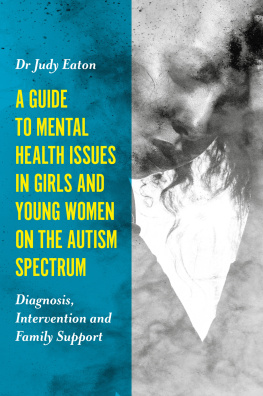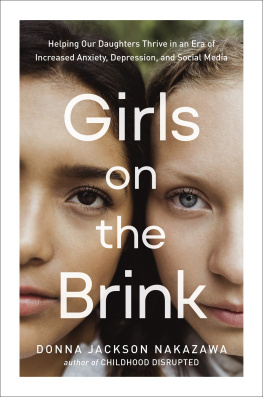Parallax Press
P.O. Box 7355
Berkeley, California 94707
parallax.org
Parallax Press is the publishing division of Unified Buddhist Church, Inc.
2016 by Urana Jackson
All rights reserved
No part of this book may be reproduced in any form or by any means, electronic or mechanical, without permission in writing from the publisher.
Cover and text design by Nancy Austin
Cover image iStock/stellalevi
Author photo Rhythm Krishna Mohan
All other photography Rhythm Krishna Mohan
Feelings Worksheet artwork on Nina Soberanis
Illustration on arlatis/Shutterstock
Illustration on MARK-N/Shutterstock
eISBN 978-1-941529-19-5
Library of Congress Cataloging-in-Publication Data is available upon request
v3.1
This is one of the best curricula Ive seen for facilitating social and emotional development for youth. Students experience transformations in self-awareness, acquire practical tools for effective communication and problem-solving, and develop genuine connection to their community.
NANCY SCHIFF, EXECUTIVE DIRECTOR FOR THE CENTER FOR YOUTH DEVELOPMENT THROUGH LAW
The teachings in this soulful, systematic sourcebook will plant the seeds of empathy and empowerment in any classroom. Jackson knows and honors adolescence: her accessible designs for community-building and conversation create space for teenagers to walk their paths with purpose and awareness.
MELINA CENTOMANI RUTTER, SAN LORENZO, CALIFORNIA, HIGH SCHOOL TEACHER
Jacksons practical ideas for promoting self-awareness, empathy, social engagement, and mindfulness are diverse enough to appeal to all kinds of girls and their mentors and parents. This is a powerful resource for both secular organizations and religious communities to use in making a real difference in girls lives.
THE REV. DR. KAREN MARIE YUST, REAL KIDS, REAL FAITH, ROWE PROFESSOR OF CHRISTIAN EDUCATION, UNION PRESBYTERIAN SEMINARY
Girls Rising is not only a well-researched, engaging program of action to support and guide girls as they navigate the harrowing complexities of adolescence. It is a poignant exhortation to tend to the souls of our girls so that they will be better equipped to fight for what is good and right in the worldbeginning with themselves.
JUNGWON KIM, SENIOR EDITORIAL MANAGER OF THE RAINFOREST ALLIANCE, MOTHER OF TEEN GIRLS
With beautiful eloquence, Urana Jackson has managed to finally give voice to the personal, social, and spiritual development of the adolescent girl. Where can I sign my clients and daughter up?
NATALIA EL-SHEIKH, MARRIAGE AND FAMILY THERAPIST
As a director of programs for a mental health agency, I am so grateful for this collection of activities for young women that Urana has put together. Girls Rising offers a comprehensive and deeply moving curriculum that can be used to help girls develop into strong and insightful women.
LILY LY, PHD
Girl Rising
After the gossamer veil of childhood has lifted
Ash and shadow spill out and
The numbing starts to quicken
While in small, heart-opening moments
When she is wild, and blind, and perfectly broken
She begins to understand that
Her gut isnt something to suck in, but to listen to.
Baring her heart unshielded is an act that both unifies and liberates, and Beauty is not a vacant image that is erected
Rather it is a goddess-given right that you grow into
Slowly
From the inside
Then
She begins to rise
Like the dawn
She stretches out and connects to the Beloved World
Touching another Self
Which she has only yet to realize.
Urana Jackson
Contents
Setting the tone, creating space, establishing guidelines, and a word about the pedagogy
Expanding and supporting girls self-awareness, self-identity, and self-esteem
ACTIVITIES:
Building the capacity for empathy and learning skillful communication
ACTIVITIES:
Examining issues facing women and girls around the world, igniting change, and developing a personal plan for meaningful social action
ACTIVITIES:
Introducing mindful meditation practices and tools, and exploring the world through a sacred lens
ACTIVITIES:
Reflecting on the journey and marking the transition
Introduction
Girls in Hiding
I began my work with girls when I was twenty-six. I was a young woman myself, still wrestling with old ghosts of self-worth and identity, as a biracial female navigating my place between a wealthy white community and middle-lower income black community; as an only child from a single-parent home; and as an extremely sensitive soul trying to make my way through the assaulting environment of Los Angeles in the 1980s. I was seeking the very empowerment that I was expected to offer the girls I was mentoring. It is no coincidence that people enter into this work as therapists, educators, and advocates with their own wounds. The ways in which we heal from them are reflected by and conducted through those people and issues we serve. As the Eastern saying quoted by Eckhart Tolle in The Power of Now: a Guide to Spiritual Enlightenment goes, The teacher and the taught together create the teaching.
My work with girls first began at an afterschool program in San Francisco public housing; three years later I moved to the girls unit at a juvenile detention center; and then, beginning in 2001, I spent thirteen years working in Oakland public schools. The young women I worked with came from a broad range of racial, ethnic, and socioeconomic backgrounds. They were vibrant, intelligent, saucy, and creative, yet many of them, regardless of their backgrounds and personal attributes, were struggling desperately with issues of depression or anxiety, drug and/or alcohol abuse, social isolation, bulimia, anorexia, cutting, perfectionism, abusive relationships, and more. It seemed like, as a collective, these girls were going through an initiation through fire, and the institutions surrounding them were ill-equipped to provide a container for such a chaotic and soul-deep passage.
Like many service providers committed to understanding and impacting a particular issue, I began my process by asking some fundamental questions: What are the deeper, underlying issues at play? In girl-centered practices I have seen, what works and what doesnt work? What is not being addressed? How can I convey what I believe is needed in a manner that is authentic, innovative, and respectful of the populations I serve? What are my personal strengths and gifts, and how can they be employed here? It has taken more than seventeen years to answer these first questions. Girls Rising is my response to that inquiry.
One of the first components in my initial search was to understand the underlying factors affecting the girls I was working with. I sought out seminal works from feminist psychologists like Carol Gilligan, Lyn Mekel Brown, and Mary Pipher, who offered critical insight into the complexity of girls development. I began to understand that at some point during the preteen years, many girls begin to lose their way, abandoning activities, beliefs, and relationships that were once life-affirming, and begin to doubt their choices, abilities, desires, and self-worth. This loss of self is evident in the myriad disturbing statistics about the psychological, emotional, and physical health of adolescent girls: seven out of ten girls ages thirteen to seventeen believe they are not good enough in regard to their looks, school performance, and relationships.


















